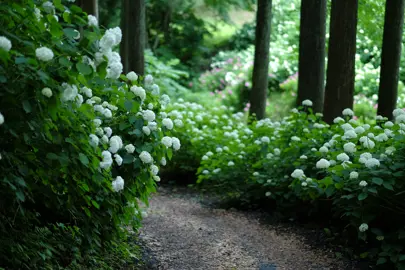
The Plant Company grows, sells, and ships Taxus trees throughout NZ. We pride ourselves on producing high quality plants and seeing the joy from our customers when they receive them. We do hope you enjoy them and support this NZ business that is passionate about Taxus trees.
Taxus baccata Fastigiata, commonly known as the Irish Yes, is a conifer grown for its attractive foliage and slender form. This evergreen has a...
Taxus baccata, commonly known as the English Yew or Common Yew, this conifer is grown for its attractive foliage and rounded form. It features small...
Taxus baccata Dovastonii Aurea is a conifer grown for its attractive foliage and form. This evergreen grows with an upright habit carrying drooping...
Taxus baccata Fastigiata Aurea is a variety of Yew grown for its attractive foliage and form. This evergreen has a rigid, upright branching habit...
Taxus baccata Fastigiata Aureomarginata is a variety of Irish Yew grown for its attractive foliage and form. This evergreen has a rigid, upright...
Taxus baccata Repandens is a variety of English Yew that is a handsome, evergreen conifer grown for its foliage and broad growth habit. It is low...
Taxus baccata Semperaurea is a stunning conifer that grows as a large, bushy, evergreen shrub. It features erect branches that carry dense...
Taxus cuspidata, commonly known as the Japanese Yew, is a conifer that grows as an evergreen tree to about 10 m tall and the same wide. It carries...
Growing colourful trees in your garden delivers a vast range of benefits:
We have the largest variety of Taxus trees, and we have the right one for your space. Our trees have been selected to thrive in NZ’s climate. We grow and stock only the highest quality plants, sourcing them locally, and from NZ’s leading nurseries. Each plant is packed and transported with extreme care, ensuring it arrives to you in the same condition it was in when it left the nursery. If you are wanting to buy Taxus trees, shop with confidence from the best in the industry.
The growth rate of Taxus, commonly known as yew, varies depending on the species, growing conditions, and individual plant. However, in general, Taxus trees are considered to be slow to moderately fast growers. Young yew trees can grow as much as 30 centimeters (12 inches) per year, while mature trees may only grow a few centimetres per year.
es, "Taxus" and "yew" are the same thing. "Taxus" is the scientific genus name for yew trees, while "yew" is the common name for the genus. There are several species of yew trees, but the most common species in Europe is Taxus baccata, which is also known as English yew or European yew.
The Yew Tree found in New Zealand is Taxus baccata, also known as English yew or European yew. This species is not native to New Zealand, but it has been introduced and cultivated as an ornamental tree. English yews are often found in gardens and parks.
Yes, all parts of the Taxus plant, except for the fleshy red arils, are poisonous. The toxicity is due to the presence of taxines, a group of alkaloids that can cause a variety of symptoms, including nausea, vomiting, abdominal pain, dizziness, and seizures. In severe cases, taxine poisoning can lead to death.
The most poisonous parts of the Taxus plant are the leaves, which contain the highest concentration of taxines. However, all parts of the plant, including the bark, seeds, and arils, contain some amount of taxines and can be poisonous if ingested.
Symptoms of taxine poisoning usually appear within 12 hours of ingestion. The severity of the symptoms depends on the amount of taxines ingested and the individual's sensitivity to the poison. In mild cases, symptoms may be limited to nausea and vomiting. However, in severe cases, symptoms can include seizures, coma, and death.
Choosing the right place to plant a yew tree is crucial for its healthy growth and thriving lifespan. Here are some factors to consider when selecting the ideal location for your yew tree:
By carefully considering these factors, you can ensure that your yew tree has the best chance of thriving in its chosen location, providing years of beauty and enjoyment.
Yew trees are known for their longevity, with some specimens estimated to be over 1,000 years old. The oldest known yew tree in the world is located in Sweden and is estimated to be over 5,000 years old.
Taxus, commonly known as yew, is a genus of evergreen conifers belonging to the Taxaceae family. They are characterized by their needle-like leaves, reddish-brown bark, and fleshy, red-colored arils that surround their seeds. Yew trees are widely distributed across the Northern Hemisphere, ranging from North America to Europe, Asia, and North Africa.
In summary, Taxus trees are a fascinating and diverse group of conifers with unique characteristics that have made them significant plants throughout human history. Their evergreen foliage, needle-like leaves, reddish-brown bark, fleshy arils, slow growth, adaptability, and cultural significance make them an intriguing addition to the natural world.
Taxus, commonly known as yew, is a genus of evergreen coniferous trees in the family Taxaceae. They are also known by several other names, including:
In addition to these common names, Taxus trees are also known by a variety of regional and vernacular names. For example, in the United Kingdom, Taxus baccata is also known as the churchyard yew, due to its frequent presence in churchyards.
Whether you need assistance finding the plant you’re looking for or you simply want to know more about who we are and what we do, we invite you to get in touch with us today. A member of The Plant Company team will get back in touch as soon as possible.


